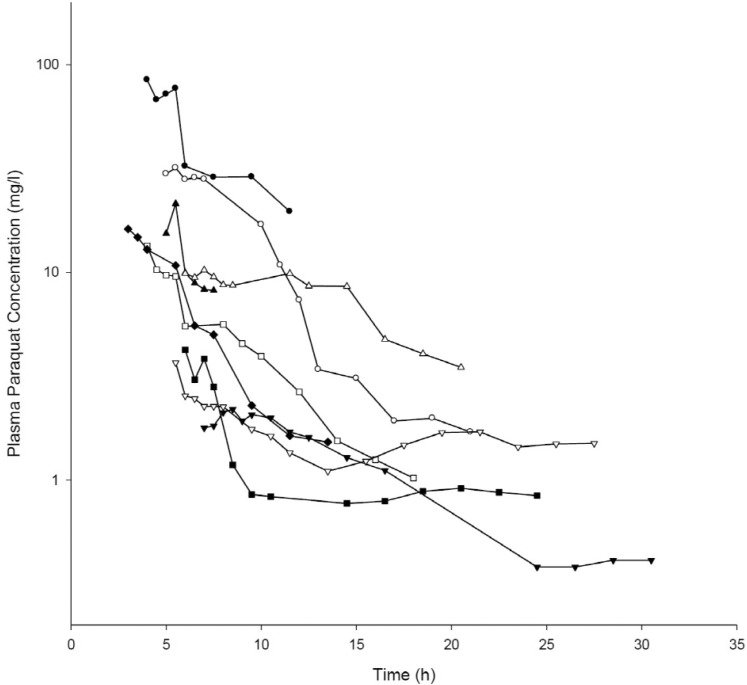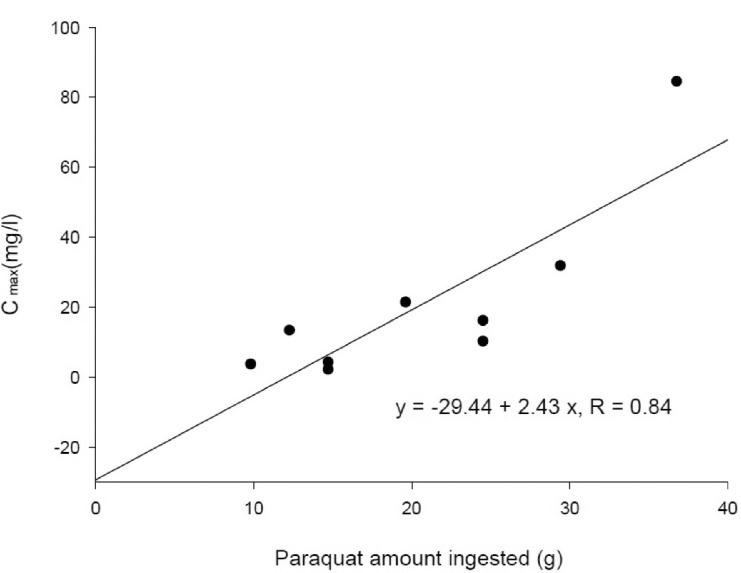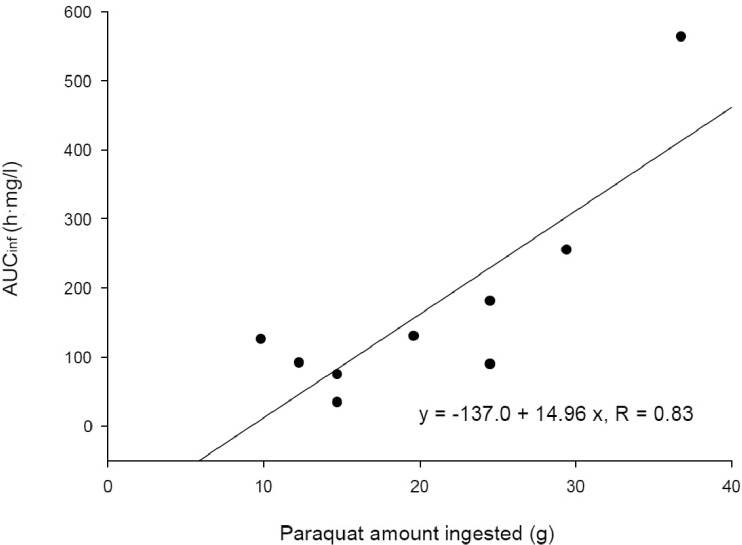Korean J Physiol Pharmacol.
2016 Jan;20(1):35-39. 10.4196/kjpp.2016.20.1.35.
Toxicokinetics of paraquat in Korean patients with acute poisoning
- Affiliations
-
- 1Department of Clinical Pharmacology, Soonchunhyang University College of Medicine, Cheonan 31151, Korea.
- 2Department of Internal Medicine, Soonchunhyang University College of Medicine, Cheonan 31151, Korea. syhong@sch.ac.kr
- KMID: 2150471
- DOI: http://doi.org/10.4196/kjpp.2016.20.1.35
Abstract
- To conduct a kinetic study of paraquat (PQ), we investigated 9 patients with acute PQ intoxication. All of them ingested more than 20 ml of undiluted PQ herbicide to commit suicide and arrived at our hospital early, not later than 7 h after PQ ingestion. The urine dithionite test for PQ in all of the nine patients was strongly positive at emergency room. Blood samples were obtained every 30 min for the first 2~3 h and then every 1 or 2 h, as long as the clinical progression was stable among the patients for 30 h after PQ ingestion. The area under the plasma concentration-time curve (AUCinf), which was extrapolated to infinity, was calculated using the trapezoidal rule. Toxicokinetic parameters, such as the terminal elimination half-life, apparent oral clearance, and apparent volume of distribution (Vd/F) were calculated. The maximum PQ concentration (Cmax) and the time to reach maximum PQ concentration (Tmax) were also obtained. Plasma PQ concentrations in nine patients were well described by a bi-exponential curve with a mean terminal elimination half-life of 13.1+/-6.8 h. Cmax and AUCinf were 20.8+/-25.7 mg/l and 172.5+/-160.3 h.mg/l, respectively. Apparent volume of distribution and apparent oral clearance were 50.9+/-61.3 l/kg and 173.4+/-111.2 l/h, respectively. There were a significant correlation (r =0.84; p<0.05) between the PQ amount ingested and Cmax. AUCinf also showed a significant correlation (r =0.83; p<0.05) with the PQ amount ingested. These correlations provide evidence that PQ has dose-linear toxicokinetic characteristics.
Keyword
MeSH Terms
Figure
Reference
-
1. Bromilow RH. Paraquat and sustainable agriculture. Pest Manag Sci. 2004; 60:340–349. PMID: 15119596.
Article2. Onyon LJ, Volans GN. The epidemiology and prevention of paraquat poisoning. Hum Toxicol. 1987; 6:19–29. PMID: 3546083.
Article3. Vale JA, Meredith TJ, Buckley BM. Paraquat poisoning: clinical features and immediate general management. Hum Toxicol. 1987; 6:41–47. PMID: 3546085.
Article4. Meredith TJ, Vale JA. Treatment of paraquat poisoning in man: methods to prevent absorption. Hum Toxicol. 1987; 6:49–55. PMID: 3546086.
Article5. Gawarammana IB, Buckley NA. Medical management of paraquat ingestion. Br J Clin Pharmacol. 2011; 72:745–757. PMID: 21615775.
Article6. Lock EA, Smith LL, Rose MS. Inhibition of paraquat accumulation in rat lung slices by a component of rat plasma and a variety of drugs and endogenous amines. Biochem Pharmacol. 1976; 25:1769–1772. PMID: 942480.
Article7. Hong SY, Hwang KY, Lee EY, Eun SW, Cho SR, Han CS, Park YH, Chang SK. Effect of vitamin C on plasma total antioxidant status in patients with paraquat intoxication. Toxicol Lett. 2002; 126:51–59. PMID: 11738270.
Article8. Suntres ZE. Role of antioxidants in paraquat toxicity. Toxicology. 2002; 180:65–77. PMID: 12324200.
Article9. Ross JH, Krieger RI. Structure-activity correlations of amines inhibiting active uptake of paraquat (methyl viologen) into rat lung slices. Toxicol Appl Pharmacol. 1981; 59:238–249. PMID: 7256766.
Article10. Proudfoot AT, Stewart MS, Levitt T, Widdop B. Paraquat poisoning: significance of plasma-paraquat concentrations. Lancet. 1979; 2:330–332. PMID: 89392.
Article11. Hart TB, Nevitt A, Whitehead A. A new statistical approach to the prognostic significance of plasma paraquat concentrations. Lancet. 1984; 2:1222–1223. PMID: 6150271.
Article12. Scherrmann JM, Houze P, Bismuth C, Bourdon R. Prognostic value of plasma and urine paraquat concentration. Hum Toxicol. 1987; 6:91–93. PMID: 3817835.
Article13. Houzé P, Baud FJ, Mouy R, Bismuth C, Bourdon R, Scherrmann JM. Toxicokinetics of paraquat in humans. Hum Exp Toxicol. 1990; 9:5–12. PMID: 2328151.
Article14. Gil HW, Kim SJ, Yang JO, Lee EY, Hong SY. Clinical outcome of hemoperfusion in poisoned patients. Blood Purif. 2010; 30:84–88. PMID: 20628243.
Article15. Hong SY, Yang JO, Lee EY, Kim SH. Effect of haemoperfusion on plasma paraquat concentration in vitro and in vivo. Toxicol Ind Health. 2003; 19:17–23. PMID: 15462533.
Article16. Suzuki K, Takasu N, Okabe T, Ishimatsu S, Ueda A, Tanaka S, Fukuda A, Arita S, Kohama A. Effect of aggressive haemoperfusion on the clinical course of patients with paraquat poisoning. Hum Exp Toxicol. 1993; 12:323–327. PMID: 8104011.17. Blake DK, Gallagher RT, Woollen BH. Improved methods for the analysis of Paraquat in biological fluid. Chromatographia. 2002; 55:S183–S185.18. Gil HW, Yang JO, Lee EY, Hong SY. Clinical implication of urinary neutrophil gelatinase-associated lipocalin and kidney injury molecule-1 in patients with acute paraquat intoxication. Clin Toxicol (Phila). 2009; 47:870–875. PMID: 19827907.
Article




